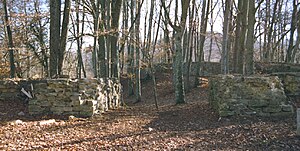Sissacherfluh ruins
| Refuge Sissacherfluh | ||
|---|---|---|
|
Weir system Sissacherfluh, access gate from the inside (March 2010) |
||
| Creation time : | Starting in the Bronze Age, several phases of development | |
| Castle type : | Hilltop castle | |
| Conservation status: | Ruin, remains of the wall | |
| Place: | Sissach | |
| Geographical location | 47 ° 28 '49 .6 " N , 7 ° 49' 4.1" O | |
| Height: | 699 m above sea level M. | |
|
|
||
The Refugium Sissacherfluh is the ruin of a hilltop castle in the Ergolz Valley in the Swiss canton of Basel-Landschaft .
location
Almost 2 kilometers north of Sissach at 699 m above sea level. M. on the rocks of the widely visible Sissacher Fluh are the remains of the Refugium Sissacherfluh. The facility is protected on the south-east, south and west sides by vertical rock walls and steep terrain. It can be easily reached from Sissach or the Sissacherfluh bus station on hiking and footpaths and offers a wonderful view of the Alps (vantage point with panorama board).
Plant and history
The Sissacherfluh weir system was used in several phases for thousands of years: accordingly, the traces of the older installations were severely disturbed. The following usage and expansion periods are roughly to be proven:
- It was first used in the late Bronze Age . A few remains of post houses were discovered in the western part of the complex.
- The main use was probably in the early Middle Ages : A 2 meter thick defensive wall (double shell with earth filling) with gate and tower at the north corners was built on the gently sloping north side to protect the entire 2.8 hectare area . This must have been much higher than what the preserved remains suggest today, because stair pillars were added at regular intervals on the inside, which made it possible to quickly man the battlements on the wall.The tower in the north corner had a level access and was perhaps even habitable. Further gate tracks in the northern foreground of the complex even give rise to the assumption of a massive but unfinished enlargement of the refuge.
- The last use from the Thirty Years War : A high watch was set up as part of the federal warning and reporting system . Four corners of the wall near the Fluh at the viewpoint are still preserved. This Hochwacht was probably protected by the now flattened, but still clearly visible double wall around the extreme end of the Fluh: Meyer suspects that this double wall already existed in the early Middle Ages and was repaired again for the Hochwacht.
Since the main parts of the complex come from prehistoric times (no written records), little is known about the history. In 1936 the facility - as part of the cantonal labor camp (employment program for the unemployed) - was largely excavated, which turned out to be difficult and expensive because of the large area.
In 2015, the Sissach municipal council decided, together with the Fritz Pümpin Foundation and the Cantonal Archeology of Baselland, to label the ruins in a suitable form. The project is to be implemented in 2016.
literature
- Jakob Horand: Summary of the main excavation results on the Sissacherfluh from 1936 . Sissach 1937.
- Franz Leuthard: About Iron Age bones (kitchen waste) from the Sissacherfluh (Baselland) . In: Report on the 10th annual meeting of the Swiss Paleontological Society. Eclogae geologicae Helvetiae . Volume 23, No. 2. 1930, pp. 589-593.
- Werner Meyer : Castles from A to Z - Burgenlexikon der Regio . Published by the Castle Friends of both Basels on the occasion of their 50th anniversary. Klingental printing works, Basel 1981, pp. 128–129.



